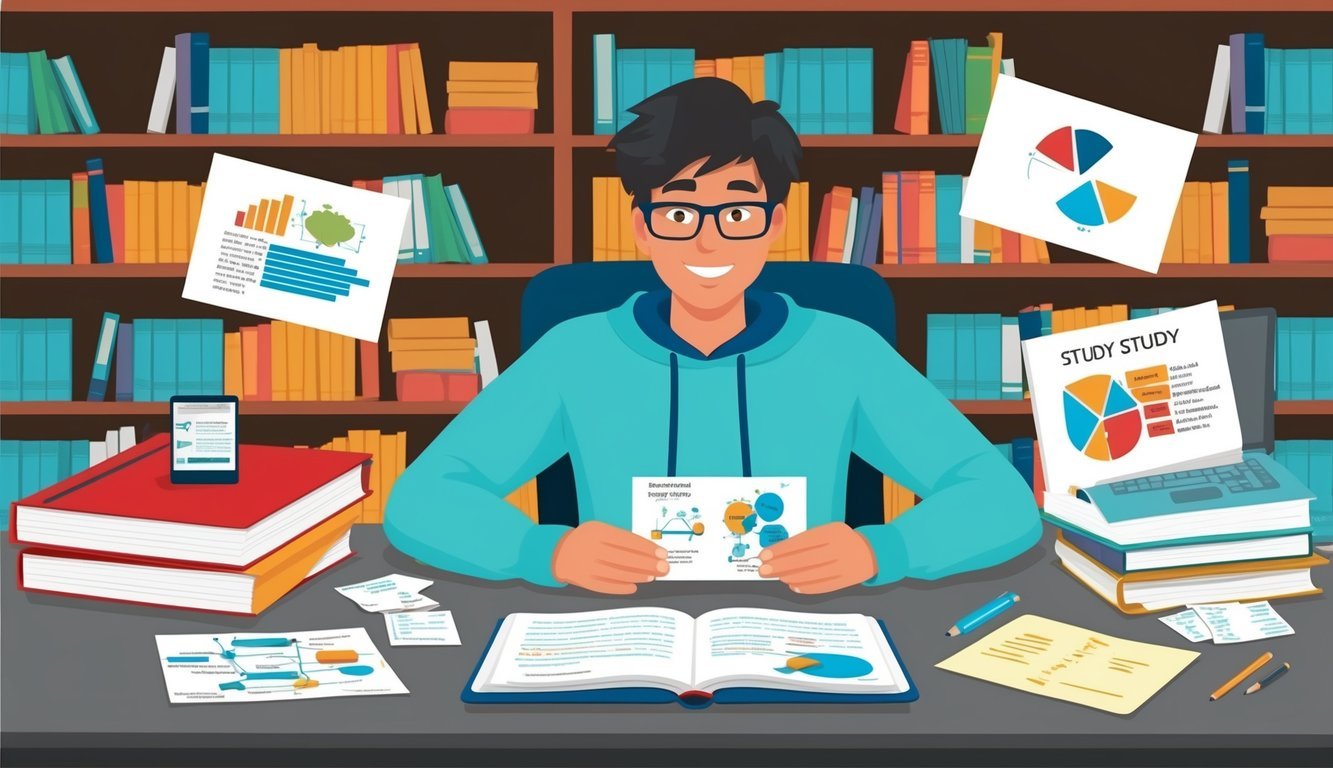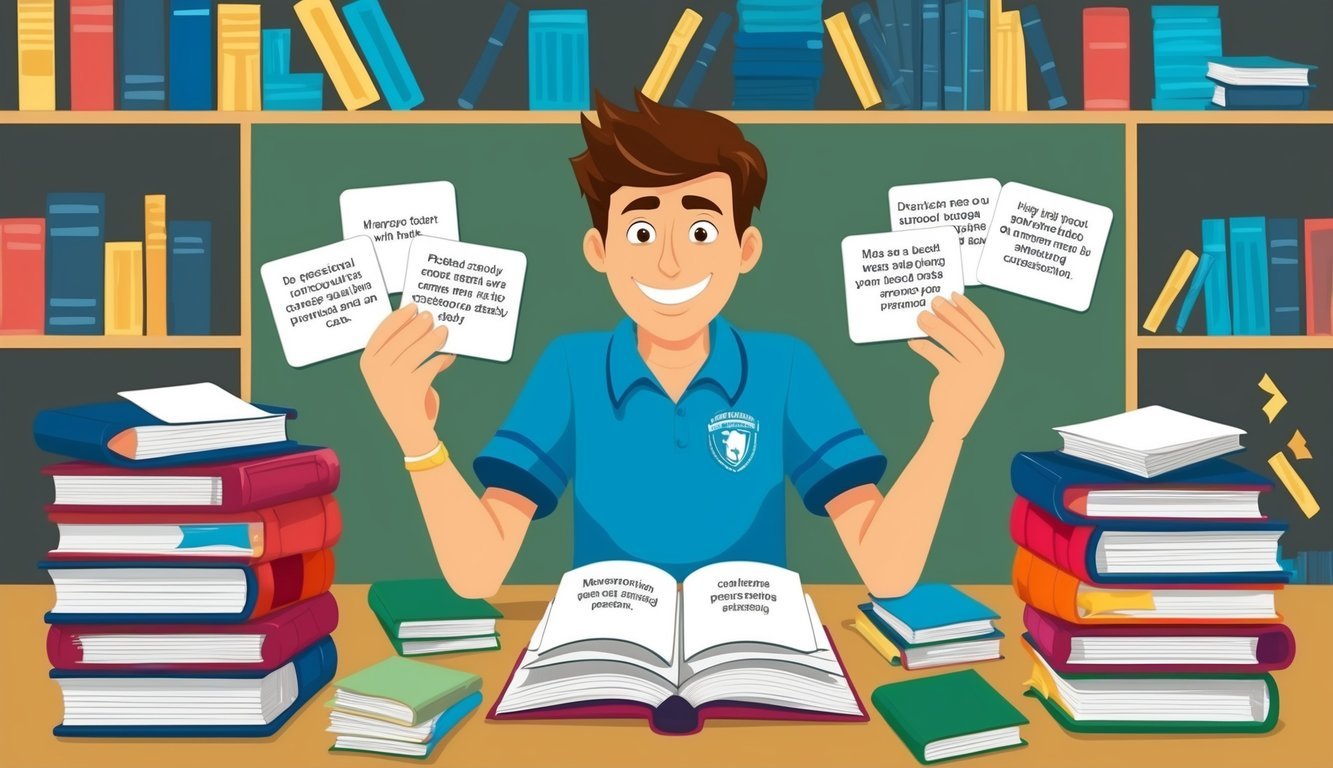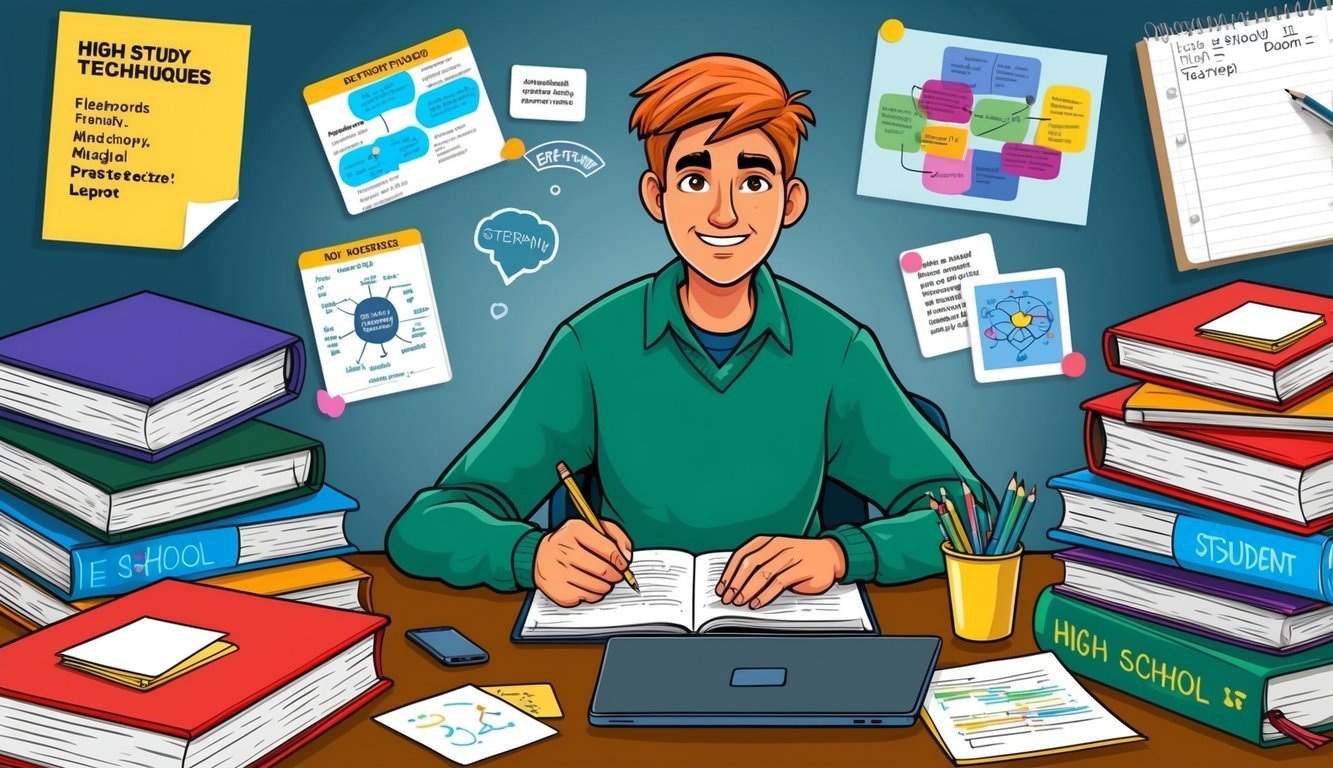Hey there, high school student! If you’re juggling classes, assignments, and exams, mastering some effective study techniques can seriously boost your grades and help you manage that overwhelming workload.
It can feel like you’re wading through a sea of books and notes, but with the right strategies, you can turn this into a smoother ride!
Using effective study techniques not only helps your grades but also makes learning a whole lot more enjoyable. Find methods that match your unique style, and you’ll improve your time management and reduce stress.
Trust me, your educational journey can be a lot more fun!
1) Pomodoro Technique
Ever heard of the Pomodoro Technique? It’s a pretty neat way to keep your study time effective while keeping your focus sharp (and let’s face it, who doesn’t need that?).
Basically, you split your study sessions into 25-minute chunks—those are your “Pomodoros.” In between, you take a quick 5-minute break.
It’s like giving your brain a breath of fresh air!
After four Pomodoros, treat yourself to a longer break, maybe 15 to 30 minutes.
It helps keep you from feeling burnt out and keeps your productivity up.
Plus, tackling one task at a time makes life a lot easier, right? And if you want, there are timer apps specifically for this technique to help you along the way.
Oh, and want to banish distractions? This technique helps with that too.
You can check out Coursera’s article for more tips!
2) Active Recall
Let’s talk about a game changer: Active Recall.
This isn’t just about passively reading your notes; it’s about actively wrestling the information from your brain.
Imagine trying to write down everything you remember from your history notes instead of just rereading them—now that’s the spirit!
Try this: cover your notes and see what you can recall.
Then, check how you did and go back for a second round.
Teaching what you’ve learned to a friend can also be a huge help.
Explaining things in simple terms highlights gaps in your knowledge and reinforces what you know.
Plus, it can be quite a laugh trying to explain math to someone who doesn’t know it at all! Research shows that this method seriously boosts retention, too.
Discover all the ins and outs of this approach by clicking here.
Trust me, it’ll make studying feel fresh again!
3) SQ3R Method
Want to ace your reading comprehension? Enter the SQ3R method.
It stands for Survey, Question, Read, Recite, and Review.
It’s all about actively engaging with your study materials—no more boring, passive reading!
First, survey the material.
Skim through headings and bold text to get the gist.
Then, turn those headings into questions—it’s like setting little challenges for yourself.
After you read, recite what you learned, whether it’s to yourself or a study buddy.
Finally, review everything to cement it in your mind.
Engaging with the material like this means it’s more likely to stick.
No one likes cramming, right? For a deeper dive into SQ3R, check out how it’s laid out at the Academic Success Center or through Stanford.
You’ll be well on your way to feeling more confident when that exam comes knocking!
4) Mind Mapping
Let’s get creatively organized with mind mapping! This nifty visual tool helps you break down complex information into bite-sized chunks.
When you study using mind maps, you can actually see how concepts connect.
Pretty cool, right?
Start with your main topic at the center and branch out to related ideas.
It’s like making a colorful spiderweb of information! This method works wonders for subjects with a lot of details—think biology or history.
Plus, visual learners really thrive with this style.
You can use plain old paper and colored pens or even digital platforms—whatever gets those creative wheels turning! For more mind mapping techniques, check out The Study Journal or Mindmaps.com.
5) Feynman Technique

The Feynman Technique is all about simplifying the complex.
Named after physicist Richard Feynman, this method encourages you to teach what you’ve learned—imagine explaining it to a sixth-grader.
By breaking it down, you spot gaps in your understanding.
Start with a topic and write down everything you know in simple terms.
If you get stuck, those are the areas to revisit.
Refining your explanation helps solidify your understanding—it’s like polishing a gem! This technique not only prepares you for exams but boosts your confidence, too.
For more tips, check out this guide on how to make this technique work for you.
6) Dual Coding

Have you tried dual coding? It’s all about pairing visuals with text to supercharge your learning.
Think of it as giving your brain a double shot of information! When you combine a graphic with words, you create more touchpoints for memory.
If you’re studying history, for instance, create a timeline to visualize events.
Or pair images with text to really nail down concepts.
There are apps that help blend images with audio or text, making it a tech-savvy strategy for all you digital learners out there.
Want to learn more? Check out The Learning Scientists for practical advice.
Try dual coding in your next study session—it could turn mundane studying into a creative effort!
7) Spaced Repetition

Last but not least, let’s chat about spaced repetition.
It’s all about timing your reviews.
Instead of cramming at the last minute, you spread out your study sessions.
Think about it: you study a topic today, revisit it in a few days, and then again in a week.
This pattern helps your memory get stronger with each pass.
It’s like watering a plant—the more you care for it, the stronger it grows!
This technique is superb for subjects requiring memorization, like vocabulary or historical dates.
There are helpful apps that track and plan your study intervals, making this a breeze.
Using spaced repetition can seriously amp up your retention rates.
It’s not just about working harder, but smarter!
How to Choose the Right Method
Choosing the right study method can feel tricky, but it’s all about your personal learning style.
Are you more visual, auditory, or kinesthetic? That can point you toward techniques like mind mapping, repeating information out loud, or incorporating movement.
Don’t hesitate to try different approaches to find what fits you best! Mixing techniques can be just as beneficial.
Combine things like interleaving with spaced repetition, for example, to enhance your learning results.
A customized study plan can make applying these effective strategies to a variety of situations much easier.
Check out College Shortcuts for ideas on combining methods.
Implementing Study Techniques in Your Daily Routine

To get the most out of your chosen study techniques, balance studying with leisure activities and keep track of your progress.
It’s crucial for maintaining a healthy routine and improving your overall learning experience.
Balancing Study and Leisure
Finding the sweet spot between studying and taking breaks can really turn your productivity up a notch.
Sure, powering through might seem tempting, but taking regular breaks actually helps sharpen your focus and retention.
Consider trying out the Pomodoro Technique: you study for 25 minutes and then take a 5-minute break.
It’s a great way to keep burnout at bay and keep your brain fresh.
During those breaks, do something relaxing—stretch, grab a snack, or listen to some music to recharge.
Creating a schedule that balances study time with fun activities can work wonders.
Build in specific study periods alongside enjoyable pursuits.
It keeps learning positive and avoids that burnout we all dread.
Tracking Progress
Tracking your study progress is key to staying motivated.
It lets you see how much you’ve accomplished and where you need to focus more attention.
Consider using study planners or apps to set daily or weekly goals.
And don’t forget about journaling! Write down what you studied and how you felt about it.
It helps pinpoint which techniques worked for you and where you might need to tweak things.
Feedback is also super helpful.
Regular reviews of your notes or testing yourself with practice quizzes can shine a light on the areas that need more work.
By keeping an eye on your progress, you can adapt your study routine to ensure it’s effective and aligned with your academic goals.

